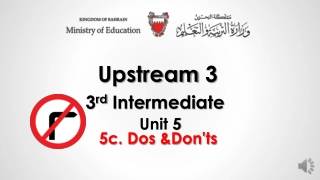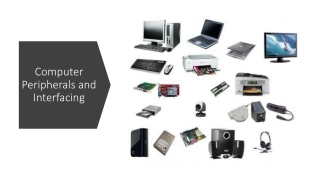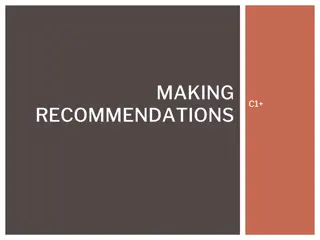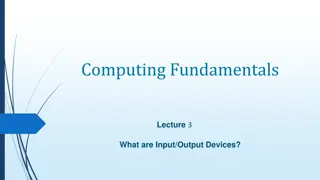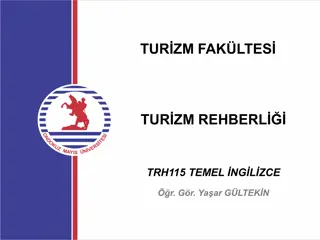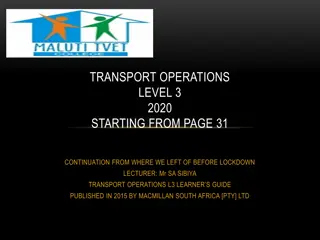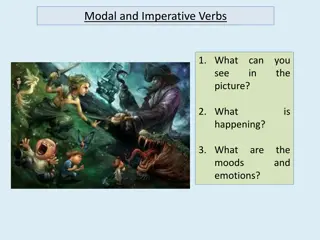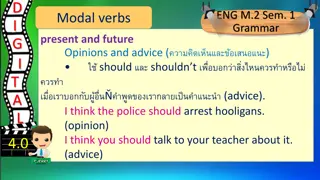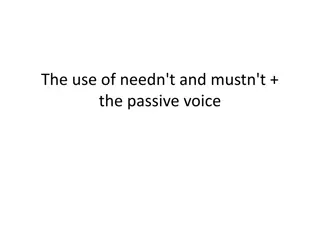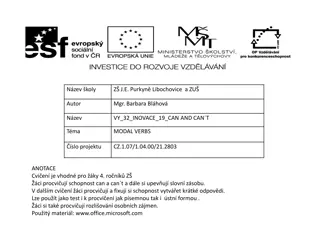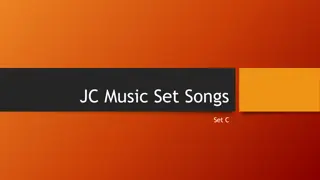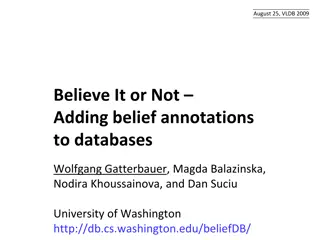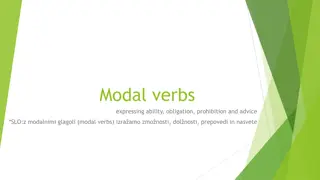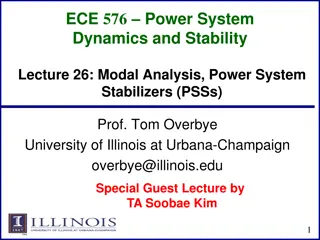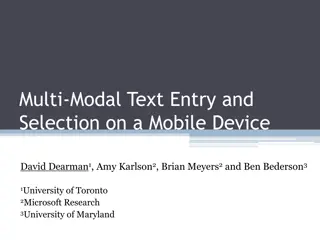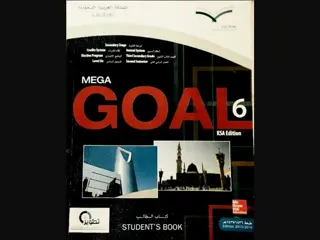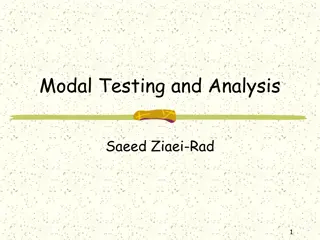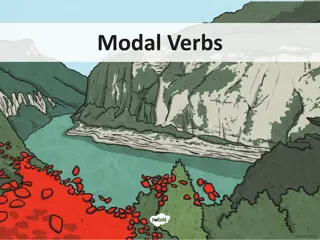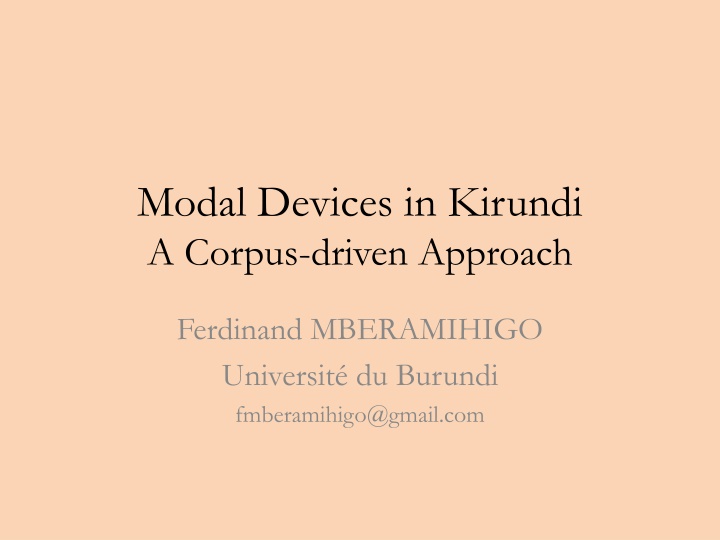
Modal Devices in Kirundi: A Corpus-driven Approach
Explore a corpus-driven approach to modal devices in the Kirundi language, focusing on types, distribution, and theoretical frameworks. Dive into the dynamic possibilities and participant-imposed modality in Kirundi through examples and analysis.
Download Presentation

Please find below an Image/Link to download the presentation.
The content on the website is provided AS IS for your information and personal use only. It may not be sold, licensed, or shared on other websites without obtaining consent from the author. If you encounter any issues during the download, it is possible that the publisher has removed the file from their server.
You are allowed to download the files provided on this website for personal or commercial use, subject to the condition that they are used lawfully. All files are the property of their respective owners.
The content on the website is provided AS IS for your information and personal use only. It may not be sold, licensed, or shared on other websites without obtaining consent from the author.
E N D
Presentation Transcript
Modal Devices in Kirundi A Corpus-driven Approach Ferdinand MBERAMIHIGO Universit du Burundi fmberamihigo@gmail.com
A corpus-driven approach Kirundi corpus Tokens : 1.918.292 Types : 204.016 Period distribution: 9 decades (1920s-2010s; 1930s: empty)
Genre/Topic & Period 1920s 200000 180000 1930s 160000 1940s 140000 1950s 120000 100000 1960s 80000 1970s 60000 40000 1980s 2010s 2000s 20000 1990s 1990s 1980s 0 1970s 1960s 2000s 1950s 1940s 2010s 1930s 1920s
Theoretical framework Van der Auwera & Plungian (1998): Modality: Possibility and necessity Nuyts (2004, 2005): Dynamic: Participant-inherent Participant-imposed Situational Deontic Epistemic
Focus Four types of modal devices used in Kirundi language : Affix auxiliary verbs epistemic adverbs
Modal affix: -oo- Potential marker traditionally labeled conditional/potential in Bantu Located between SC and root. The most widely used and has the largest semantic scope and the greatest number of modal values. Therefore, it stands as the grammatical morpheme dedicated to the expression of modality in Kirundi.
Dynamic possibility Participant-inherent Dynamic Possibility (P-In DyPo): Uburundi naje nobutwara. Burundi, I am also able to govern it (Mugororoka, News, 1970s) u-bu-ru ndi AUG14-NP14-Burundi na also je me n-oo-bu-tw ar-a SC1sg-MOD-OC14-govern-PFV
Dynamic possibility (2) Participant-imposed Dynamic Possibility (P-Im DyPo): ejo uraza kundamutsa, niho tworonka n'akanya ko kuganira. tomorrow, come and visit me, so that we can have at least some time to talk. (Rumarantimba, Drama, 1980s) ej u-ra- z-a ku-n-ramuts-a tomorrow SC2sg-HORT-come-IPF NP15-OC1sg-visit-IPF COP PP16-PRCS ni ha- tu-oo-roonk-Ha SC2pl-MOD-get-REL.IPF at.least n a-ka- nya AUG12-NP12-time PP12-CONN ka- ku-g aniir-a NP15-talk-IPFV
Dynamic possibility (3) Situational Dynamic Possibility (SiP): Umuntu arashobora guhema umwotsi w itabi awutumuriweko n uwurinywa. A person can breathe tobacco smoke when he is smoked out by someone who smokes. (USCRI_H_QuitSmoking, Health, 2000s) u-mu-ntu AUG1-NP1-person a-ra-sh bor-a ku-heem-a u-mu- otsi SC1-DISJ-can-IPFV NP15-breathe-VF AUG3-NP3-smoke aH-u-tuumuur-ir-u-ye-k SC1.CJC-OC3-smoke.out-APPL-PASS-PFV-POSTF17 u-a i- -ta bi PP3-CONN AUG5-NP5-tobacco na by u-u-ri-ny -a AUG1-SC1-OC5-smoke-IPFV
Deontic possibility Imana yabariye Adamu iti: Urashobora kurya ivyamwa vyose uretse igiti kiri hagati mu murima . God said to Adam: You can eat of all the fruits, except of the tree which is in the middle of the garden . (CU110308Umuro, Peace, 2010s) i-N-m ana AUG9-NP9-God i- -b rir-ye SC9-PE-say-PFV Adam Ada mu i-ti u-ra-sh bor-a SC9-QUOT SC2sg-DISJ-can-IPFV ku-r -a NP15-eat-IPFV AUG8-NP8-fruit PP8-all i-bi-a mwa bi- se ur tse except i-ki-t AUG7-NP7-tree ki-riH SC7-be.REL in.the.middle LOC18 i-ki-t AUG7-NP7-tree hagat mu mu-rim NP3-garden
Epistemic possibility Iryo dini rero ryoba ryatangira izo nyigisho mu kinyegero kuko mu masengero yabo basa n'abatanga inyigisho nziza. So this religion may have given these precepts in secret because in their churches they seemed to give good precepts. (Mushingantahe, Paix, 2000s) riH- -t ang-ir-a i-ri-o AUG5-PP5-DEMb -din NP5-religion then reer ri-oo-b -a SC5-MOD-be-VF SC5.CJC-PE-give-APPL-VF i-zi-o AUG10-PP10-DEMb mu LOC18 NP6-church N-y giisho NP10-precept a- bo PP6-POSS2 mu LOC18 ba- -se-a SC2-HP-seeem-VF with ki-nyegero NP7-secret because na kuk ma-sengero a-ba- -t ng-a AUG2-PP2-HP-give-IPFV AUG10-NP10-precept i-N-y giisho N-(z)iiz AP10-good
Dynamic necessity Participant-inherent Dynamic Necessity (P-In DyNe): Dawe wo mw ijuru arazi ko dukeneye kwambara n ugufungura. Our Father in Heaven knows that we need to dress and to eat. (Yaga, Religion, 1960s) daaw u- mu i- -juru our.father PP1-CONN LOC18 AUG5-NP5-heaven SC1-DISJ-know tu-kener-Hye ku-ambar-a SC1pl-need-REL.PFV NP15-dress-IPFV and AUG15-NP15-eat-IPFV a-ra- zi k that n u-ku-fuungur-a
Dynamic necessity (2) Participant-imposed Dynamic Necessity (P-Im DyNe) Ibimazi vy mury ngo n ik ntu umury ngo uteg rezwa kw ma uf se kug ra ngo ur nk umugisha. Family amulets are something a family must keep constantly so that it would have a blessing. (IntaraKama, Traditional Culture, 2010s) i-bi-mazi bi-a u-mu-ryaango AUG8-NP8-amulet PP8-CONN AUG3-NP3-family COP ni i-ki-ntu AUG7-NP7-thing u-t gerezw-Ha u-mu-ryaango AUG3-PN3-family SC3-must-REL.IPFV ku- m-a NP15-be.constantly-IPFV uH-f t-ye SC3-have-PFV so u-roonk-He SC2sg-get-SBJF.PFV AUG3-NP3-chance kug ra ngo that u-mu-gisha
Dynamic necessity (3) Situational Dynamic Possibility (SiP): Ivyo bihe bitegerezwa gushikira na cane cane ikiremwa muntu kandi nta ko avyirinda kuko ni ntabanduka. These times must happen especially to the human being and there is no way of eluding them because they are ineluctable. (CU100427, Peace, 2010s) i-bi-o bi-he bi-t gerezw-a ku-shik-ir-a AUG8-PP8-DEMb NP8-time SC8-must-IPFV NP15-happen-APPL-IPFV and na caanec ane especially i-ki-remw AUG7-NP7-being mu-ntu NP1-human and COP.NEG PP15-PRCS ka ndi nta ku-o a-bi-iriind-Ha SC1-OC8-elude-REL.IPFV kuk ni because COP ntabaand uka ineluctable
Deontic necessity Ingene Bakwa. Umusore waho agomba kukwa umugore, abwirizwa kutanga inka zine canke zitanu, canke zitandatu. How they pay dowry. A young man from there who desires a wife must give four, five or six cows. (Rusizira4603Akatangaza, News, 1940s) ba-k -Ha SC2-pay.dowry-REL.IPFV ing ne how u-mu-s re AUG1-NP1-young.man PP1-POSS16 u- aho a-goomb-Ha SC1-desire-REL.IPFV ku-k -a NP15-pay.dowry-IPFV u-mu-gor AUG1-NP1-wife a-bw irizw-a AUG1-must-IPFV ku-t ang-a i-N-k PN15-give-IPFV AUG10-NP10-cow zi-n PP10-four caank or zi-taanu PP10-five caank or zi-taand tu PP10-six
Epistemic necessity Icara ndagusomye mbona umengo akazuba kaguciyeko, utegerezwa kuba unyotewe. Sit down, let me share beer with you, I see that, apparently sun passed on you, you must be thirsty. (Umugumyabanga, Drama, 1990s) N-ra-ku-som-i-He SC1sg-DISJ-OC2sg-drink-CAUS-SBJV.PSP icar-a sit.down-IPFV N-b n-a SC1sg-see-IPFV umeengo apparently a-ka-zu ba AUG12-NP12-sun ka-a-ku-c -ye-k SC12-HP-OC2sg-pass-PFV-POSTF17 uH-ny oterw-ye SC2sg.CJC-be.thirsty-PFV u-t gerezw-a ku-b -a SC2sg-must-IPFV NP15-be-IPFV
Auxiliaries Typical construction: followed by an infinitive (see slides 11,12). Possibility: -sh bor- (be able), -sh bok- (be possible), -b ash- (be able), -k und- (be possible), -b n- (be able), -rekuriw- (be allowed) and - merew- (be allowed); each of them covering a modal scope in its way. Necessity: -t gerezw- (must), -bw irizw- (must), -kener- (need), -riind- (need), -kw ir- (should), -b er- (be necessary) and -goomb- (must).
Epistemic adverbs Epistemic adverbs (14) Six expressing possibility: ngirango, umeengo, nkeeka, kuumbur , kur ubu, ub na ( maybe ) One expressing necessity (certainty): kok ( certainly ) One epistemic (umeengo ) overlapping to evidentiality (15) [Mberamihigo & al. forthcoming).
Overlap to evidetiality: umeengo Yinjiranye n umukobwa, kandi umengo ni Janine! He entered with a lady, and apparently it is Jeanine! (Nyerek akaranga, Drama, 1970s) a- njir-an-ye SC1-enter-ASSOC-PFV na with u-mu-ko bwa AUG1-NP1-lady ka ndi and umeengo apparently ni COP jani ne Jeanine
Conclusion A set of modal markers With different scopes Grammaticalized to different extents. Some structures typical of the expression of modality.
References de Haan, Ferdinand. 2006. Typological Approaches to Modality. In W. Frawley, E. Eschenroeder, S. Mills & T. Nguyen (eds.), The Expression of Modality. Berlin; New York: Mouton de Gruyter. 27-69. Mberamihigo, Ferdinand. 2014. L expression de la modalit en kirundi. Exploitation d un corpus lectronique. Bruxelles: Universit libre de Bruxelles, th se de doctorat. Mberamihigo, Ferdinand , Gilles-Maurice de Schryver & Koen Bostoen. forthcoming. Entre verbe et adverbe: Grammaticalisation et d grammaticalisation du marqueur pist mique umeengo/umeenga en kirundi (bantou, JD62). JALL Nuyts, Jan & J. van der Auwera (eds.). 2015. The Oxford Handbook of Mood and Modality. Oxford: Oxford University Press. van der Auwera, Johan & Valentin A. Plungian. 1998. Modality's semantic map. Linguistic Typology 2: 79-124.

